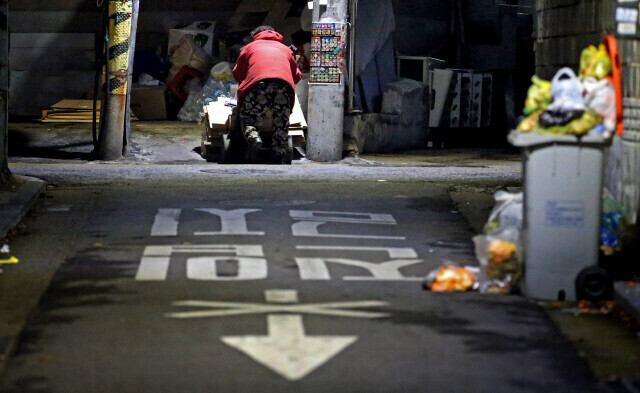hankyoreh
Links to other country sites 다른 나라 사이트 링크
40% of Koreans 66 and up are living in poverty, the highest rate in OECD

South Korea has the highest rate of poverty in old age in the Organisation for Economic Co-operation and Development. As of 2020, four out of 10 South Koreans aged 66 and older fall below the poverty line. The poverty rate also worsens as people get older.
The OECD recently published its report, “Pensions at a Glance 2023.” The OECD defines relative income poverty as having an “income below half the national median equivalised household disposable income.” According to the report, 40.4% of South Koreans aged 66 and older fall into this category, the highest elderly income poverty rate among the 37 nations analyzed in the report.
The average old-age income poverty rate among OECD nations is 14.2%, which is about a third of South Korea’s. South Korea has persistently remained at the top of the OECD’s rankings of old-age income poverty rates since the organization started publishing “Pensions at a Glance” in 2009.
After Korea, the OECD countries with the highest relative poverty for people over 65 were Estonia (34.6%), Latvia (32.2%), and Lithuania (27.0%). The US and Australia recorded 22.8% and 22.6%, respectively, while Japan’s elderly poverty rate was 20% – roughly half of South Korea’s. Western and Northern Europeans had the lowest rates of elderly poverty, as demonstrated by Iceland (3.1%), Norway (3.8%), Denmark (4.3%) and France (4.4%).
South Korea also had the biggest disparity between its general poverty rate (15.3%) and its elderly poverty rate, at 25.1 percentage points. Following Korea were Estonia at 18.8 percentage points and Latvia at 16.2 percentage points. In France, Greece, Luxembourg, Norway, and Spain, the elderly poverty rate was actually below the general poverty rate.
As expected, a sickly pension system was a major contributor to South Korea’s elderly poverty. Compared to other OECD nations, South Korea has fewer people who receive pensions, and their pensions are smaller.
“In Korea, the pension system is still maturing, and current generations of very old people still have very low pensions,” the OECD report states
The poverty rate among South Korea’s “older old,” or those aged 76 and older, is 52%, significantly higher than the standard poverty rate for those aged 66-75, 31.4%. The OECD average elderly poverty rate is 12.5% for the 66-75 age group and 16.6% for those aged 76 and older.
South Korea’s poverty rate for women in old age was 45.3%, a full 11.3 percentage points higher than Korean men in old age, 34%. The OECD average elderly poverty rate for men was 11.1% for men and 16.5% for women. The report points out that women tend to have lower pensions than men while having longer life expectancies, which elevates their poverty rates.
By Cheon Ho-sung, staff reporter
Please direct questions or comments to [english@hani.co.kr]

Editorial・opinion
![[Column] Season 2 of special prosecutor probe may be coming to Korea soon [Column] Season 2 of special prosecutor probe may be coming to Korea soon](https://flexible.img.hani.co.kr/flexible/normal/500/300/imgdb/original/2024/0426/3317141030699447.jpg) [Column] Season 2 of special prosecutor probe may be coming to Korea soon
[Column] Season 2 of special prosecutor probe may be coming to Korea soon![[Column] Park Geun-hye déjà vu in Yoon Suk-yeol [Column] Park Geun-hye déjà vu in Yoon Suk-yeol](https://flexible.img.hani.co.kr/flexible/normal/500/300/imgdb/original/2024/0424/651713945113788.jpg) [Column] Park Geun-hye déjà vu in Yoon Suk-yeol
[Column] Park Geun-hye déjà vu in Yoon Suk-yeol- [Editorial] New weight of N. Korea’s nuclear threats makes dialogue all the more urgent
- [Guest essay] The real reason Korea’s new right wants to dub Rhee a founding father
- [Column] ‘Choson’: Is it time we start referring to N. Korea in its own terms?
- [Editorial] Japan’s rewriting of history with Korea has gone too far
- [Column] The president’s questionable capacity for dialogue
- [Column] Are chaebol firms just pizza pies for families to divvy up as they please?
- [Column] Has Korea, too, crossed the Rubicon on China?
- [Correspondent’s column] In Japan’s alliance with US, echoes of its past alliances with UK
Most viewed articles
- 1‘We must say no’: Seoul defense chief on Korean, USFK involvement in hypothetical Taiwan crisis
- 2AI is catching up with humans at a ‘shocking’ rate
- 3Is Japan about to snatch control of Line messenger from Korea’s Naver?
- 4Division commander ordered troops to enter raging flood waters before Marine died, survivor says
- 5[Column] Season 2 of special prosecutor probe may be coming to Korea soon
- 6Is N. Korea threatening to test nukes in response to possible new US-led sanctions body?
- 7[Guest essay] The real reason Korea’s new right wants to dub Rhee a founding father
- 8Korea sees more deaths than births for 52nd consecutive month in February
- 9[Editorial] Korea’s surprise Q1 growth requires objective assessment, not blind fanfare
- 10One Hyundai worker suffers through 16 piecemeal contracts in 23 months